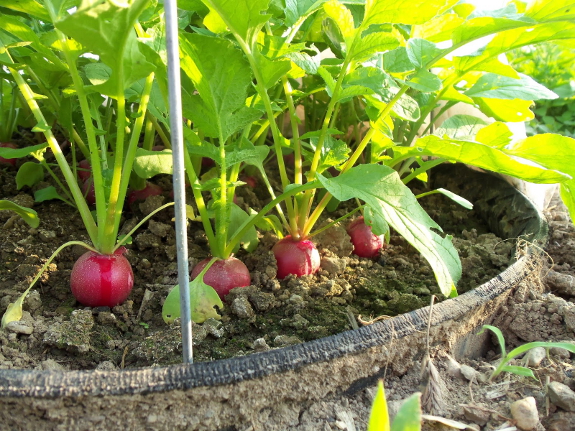
Tire garden beds
I enjoyed reading Kimball's chapter on making tire
garden beds not so much because I want to follow his lead, but because I
like hearing about working with tires. I'm still looking for the
perfect use for this waste product on our own homestead, so his ideas
were welcome.
When making garden beds out of tires, Kimball recommends cutting off the
sidewalls with a jigsaw to turn your tire into a more space-saving
container. After removing the sidewalls, he turns the remaining
part of the tire inside out, which makes it a bit more vertical (and
hides the tread). Finally, Kimball learned the hard way that it's
best to sink your tire into the ground if you don't want your crops to
dry out.
Where do I see potential
for using tires on our farm? If I'd been smart, I would have sunk a
processed tire into the ground as a root barrier before planting my
mint. And I could see using tire raised beds to help me build the
soil up in the forest garden, where the groundwater is so close to the
surface that roots often drown. I'll bet you can come up with even
more good ideas for using tires in the garden --- feel free to share
them in the comments section!
| This post is part of our Idea Book for Gardeners lunchtime series.
Read all of the entries: |
Want more in-depth information? Browse through our books.
Or explore more posts by date or by subject.
About us: Anna Hess and Mark Hamilton spent over a decade living self-sufficiently in the mountains of Virginia before moving north to start over from scratch in the foothills of Ohio. They've experimented with permaculture, no-till gardening, trailersteading, home-based microbusinesses and much more, writing about their adventures in both blogs and books.
Want to be notified when new comments are posted on this page? Click on the RSS button after you add a comment to subscribe to the comment feed, or simply check the box beside "email replies to me" while writing your comment.


I am in the midst of preparing for a tire garden. I have about 3/4 of the tires cut and in place. Now I am starting to worry about any possibility of chemicals from the tires leaching into the soil that contain my plants. Thoughts?
Looking at the picture, I see a patch of radish(?) sitting in a garden with part of a tire around it.
Why bother putting in the tire? Wouldn't it grow just as good or bad without it?
Roland --- I'd say aesthetics is the primary reason, which is why I've never gardened in tires. However, they could be useful as a root barrier for plants that are prone to becoming invasive, and they could also solidify raised beds.
However, they could be useful as a root barrier for plants that are prone to becoming invasive, and they could also solidify raised beds.
Andrea and Maggie --- Here's what Kimball writes about leaching: "Some people have expressed concerns about using old tires in the garden because of the possibility that chemicals may leach out of the rubber. As far as I know this is not really an issue. Tires seem to be very stable and I'm not personally concerned that they are a source of contamination. Nevertheless, you should be aware of the matter. Paul Farber, author of 'Tire Recycling is Fun' discusses the safety of tires for garden beds in more depth at his web site TireCrafting.com."
It's the resistance to degradation of the tire that makes it such a problem after disposal. That also means leaching is probably a minimal concern when used in your garden. And rubber is, after all, organic.
Of more danger, I would bet, is stepping on the sharp metal mesh in the tread as the rubber oxidizes and crumbles away over time.
patrice at rural revolutions has been using tires for most of her garden. there are extensive entries into the subject, including citing studies on tires leaching (they don't). She takes some great pictures and has had a couple seasons of results, you might find it interesting.
http://www.rural-revolution.com/search/label/tire%20garden
The composition of tires and what compounds are released by them is covered in this collection of reports (PDF).
From the reports, there doesn't seem to be a significant danger.
With regards to zinc (which is used as an activator in the sulpher vulcanization of rubber in the form of zinc oxide "ZnO"), this metal is also widely used to protect iron and steel from rusting. This is commonly called "galvanization" or zinc-plating. So if you have e.g. zinc-plated gutters or roofing material and some buried tires in the garden it is impossible to tell where elevated levels of zinc come from, if any.